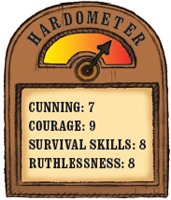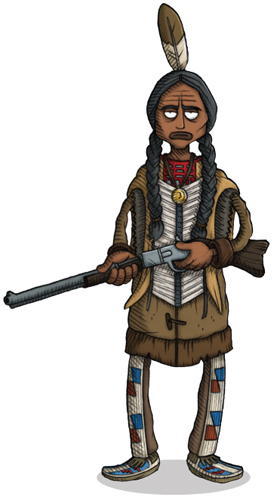

Sitting Bull was a Native American warrior who fought to keep his people in their homeland.
JUMPING BADGER
Sitting Bull was born around 1831, a member of the Teton Sioux tribe. He was named Jumping Badger, and only given his father’s name, Sitting Bull, after his first battle with another tribe, the Crow tribe, when he was fourteen.
THE SETTLERS ARRIVE
By the time Sitting Bull was eighteen, European settlers were moving westwards through Sioux lands (what’s now Montana, Nebraska, Wyoming and North and South Dakota), especially after the California Gold Rush of 1849. There were frequent fights, in which Sitting Bull gained a reputation for bravery.
GOLD!
In 1866, Sitting Bull was made chief of the whole Sioux nation. In the mid 1870s, gold was discovered in the Black Hills of Dakota, where the Sioux lived. The US government ordered the Native Americans to move into particular areas, called reservations, because they were getting in the way of the gold hunters. Sitting Bull was having none of it. He prepared to fight.
LITTLE BIGHORN
Sitting Bull gathered together the Sioux, Cheyenne, and some of the Arapaho tribes in the valley of the Little Bighorn River. In June 1876, Lieutenant Colonel Custer led his soldiers to their camp. Massively outnumbered by the Native Americans, Custer and all his men were killed.

EXILE
The US army were so angry about what had happened to Custer that they forced many of the Sioux and other tribes to live on reservations. Sitting Bull led his people to Canada, where they lived a nomadic life hunting bison. But since the Europeans had arrived, the bison the Sioux depended on for food and hides had almost been wiped out. After four years, hunger drove Sitting Bull and his followers to surrender, and they went to live on a reservation. For a few months Sitting Bull joined Buffalo Bill’s Wild West Show, a touring show that included displays of shooting and horse riding. Although he earned quite a lot of money by charging for autographs and photographs, he gave most of it away to beggars and the homeless.
SITTING BULL’S SAD END
In 1890, Native American police arrested Sitting Bull because they were worried that he might stir up trouble again. Over forty men were sent out to arrest him in a dawn raid. When Sitting Bull’s followers found out what was happening, they started a fight. Sadly, the police retaliated by shooting Sitting Bull dead. He has become famous as a symbol of resistance.
Find out more about Native American tribes here.
![]()
